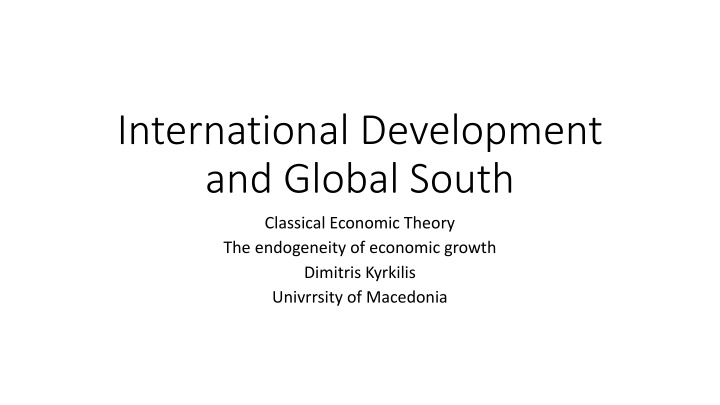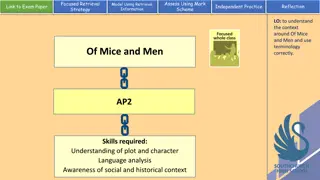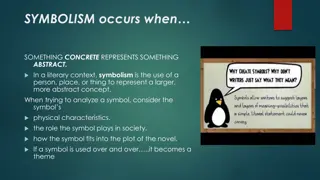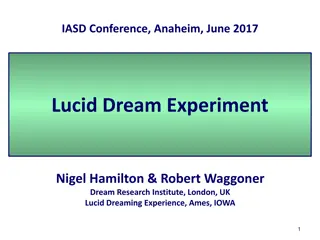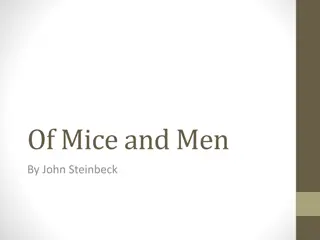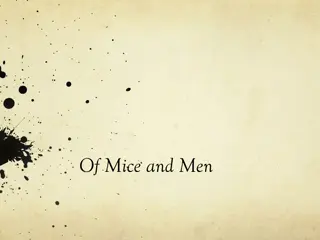Themes in "Of Mice and Men": The American Dream
The American Dream in "Of Mice and Men" explores the longing for independence and stability among ranch workers striving for a better life and recognition despite their circumstances.
Download Presentation

Please find below an Image/Link to download the presentation.
The content on the website is provided AS IS for your information and personal use only. It may not be sold, licensed, or shared on other websites without obtaining consent from the author.If you encounter any issues during the download, it is possible that the publisher has removed the file from their server.
You are allowed to download the files provided on this website for personal or commercial use, subject to the condition that they are used lawfully. All files are the property of their respective owners.
The content on the website is provided AS IS for your information and personal use only. It may not be sold, licensed, or shared on other websites without obtaining consent from the author.
E N D
Presentation Transcript
International Development and Global South Classical Economic Theory The endogeneity of economic growth Dimitris Kyrkilis Univrrsity of Macedonia
1stIndustrial Revolution The introduction of: 1. the industrial production system, i.e. Production takes place in factories, 2. new production machinery due to technological progress based on advancements of scientific knowledge, e.g. internal combustion engine Led to rising labour productivity through improvements of the division of labour, i.e. labour specialisation; to the proliferation of the capital intensive mode of production resulting to the production standardisation and to mass production, i.e. realisation of economies of scale and thus to decreasing average production cost, hence prices. That in turn enlarged markets, output, employment, incomes, consumption, and so on.
1stIndustrial Revolution Structural Transformations Shares of Global Output by Continent 1st Industrial Revolution 1/3 1/3 1500 A.D 1/5 2/3 Europe Asia Per Capita Income 0-500 ad 1stIndustrial Revolution 1914 480$ 1500$ 1850-1960 7800$ Cumulative growtth by more than 5 times
1stIndustrial Revolution Structural Transformations Embedment of economic growth of the metropolitan European powers Imperialism, i.e. system of multinational continental empires, e.g. Ottoman, Russian, Habsburg Monarchy, etc. and colonial empires, e.g. British Empire along overseas colonial expansion of main continental European powers. The highest stage of imperialism was reached with the partition of Africa at the Berlin Conference 1884-85.
1stIndustrial Revolution: Structural Transformations The expansion of capitalism through imperialism, especially colonialism led to the development of hierarchical international relations, embeded an unequal division of labour between the industrialised and developed metropolitan powers and the agrarian underdeveloped South that led to unequal exchange and generated developmt dependency paths. Income inequalities were embeded between developed and underdeveloped countries but also within the industrialised countries as result of the function of capitalism and the division between wage earners, i.e. labour and profit earners, i.e. capital.
Adam Smith proposed a development model from the supply side point of view Production function: = f (L, K, T, TFPr) L=labouf, K= capital, T= cultivated land, TFPr= total factor productivity Output is a function of: Cooperation of inputs, i.e. L, K, T Endowment level (supply level) of inputs Productivity of inputs Change, denoted by D of output: D = f(DL, DK, DT, DTFPr)
The secret of increasing productivity: Increasing Division of Labour . Smith argues that labour productivity (MPL) is a function of the division of labour in his famous example of the nail factory, in which the production process is divided in 18 distinguished stages. Workers are assigned different duties activities. They perform their duties in imoroving accuracy and speed as they learn by doing, while the speed of the process increases as new machinery as result of technological innovation (progress) is being introduced leading to further division of the production process, that increases X o Smith . 18 , . ). Increases the division of labour to simpler activities, in turn it increases labour productivity, hence production output. In Smith s factory 1 worker makes 1 nail while 10 workers make 4800 . The division of labour increases labour productivity by 240 times.
Therefore, the secret of increasing labour productivity is the increasing division of labour, the secret of which is the introduction of new more advanced machinery.
Therefore, the secret of increasing labour productivity is the increasing division of labour, the secret of which is the introduction of new more advanced machinery.
Introduction of new more advanced Machinery to the production process is achieved through new Introduction of new more advanced Machinery to the production process is achieved through new investment leading to capital accumulation, i.e. Change of capital (DK) investment leading to capital accumulation, i.e. Change of capital (DK) Y increases due to: 1. rising capital stock Technological progress introduction of new more advanced machinery to the production process further labour specialisation rising labour productivity (MPL) DY (positive) = f( profit rate (+), market size (+)) Profit rate is a positive function of the capital share of income. The latter increases as income is redistributed in favour of capital and at the expence of labour. Market size =(+) f( , pdoductivity, international trade)
The realisation of investment depends on the availability of financing. In a closed economy financing depends on savings. S = Y C Where C: consumption Wage earners have high average propensity to con sume ( APC) but low average propensity to save ( APS) Capital owners have high APS but low APC. S=f(Scapital ownrers)=f(Ycapital owners) = f(profits)= f(MPK) MPK profits capital ownrrs S capital owners S ( )
Problem: As the accumulation of capital rises MPrK decreases, so it does the income of capital, hence profits. Solution: Continuous growth of Y so the share of capital increases in a natural sence. Continuous income growth is safeguarded by continuous technological progress that in turn increases productivity. But technological progress depends on scientific progress that comes in waves. Periods of slow or no technological progress lead to slow or no income growth, therefore redistribution of income in favour of capital and at the expence of labour is required.
The system is sustained through inequality In any case, the rate of technological progress there is no sufficient reason to be at a level sufficient to sustain an economic growth rate sufficient to generate sufficient additional profits, therefore sufficient additional savings for financing a sufficient investment rate to trigger a sufficient economic growth rate. Hence, the increase of the wage share in the national income, even if labour productivity increases has to be limited, i.e. Wages increase at a rate lower than the one of labour productivity in order t maintain profits.
There is an structural tendency of the profit rate to fall The essential cause of the falling profit rate is the accumulation of capital (law of diminishing returns) Competition to attract L to undertake additional production. When full employment the only way to do so is to transfer L from other sectors of the economy motivating it by offering higher wages, thus shrinking the profit share of Y. MPK profit rate Capital Income Scapital owners I setting certain roof to capital accumulation W the income share pertained to capital MPL However, the profit rate should be sustained in order to sustain the income received by capital, hence the S capital S Solution: Income redistribution in favour of profits.
The Income Distribution is an Economic Growth Determinant.
Endogenous growth of labour L= f(change of population) = f(living standards,i.e. food, shelter, clothig, sanitation,etc.) W consumption of goods and services pertained to living standards rate of births of population, hence of L If Labour supply (rate) relatively more than the rate of L demand Wages decrease, hence living standards, therefore of rate of births, rate of population change, rate of DL .Gradually W increases, and so on.
Market Size Capital intensity increases: 1. productivity that increases output then market size, 2. Economies of scale then decreases average production cost, hence price. More consumers may afford products, consumption and consequently output increases In total: markets expand and this facilitates the introduction of new machinery, thetefore investments increase generating more economies of scale, and so on. Markets increase through increasing exports, i.e. free international trade. Contries specialise and export products where they enjoy relatively higher productivity and imports those products where relatively productivity is lower (law of absolute and then comparative advantages)
Synopsis Synopsis Economic growth is endogenous to the economic system Technological progress Introduction of machinery through Investmenting to the production process Division of Labour MPL Y Investments =f(profits, market size) Profits = f(Distribution of ) Market Size = f(Y, productivity, international trade)
